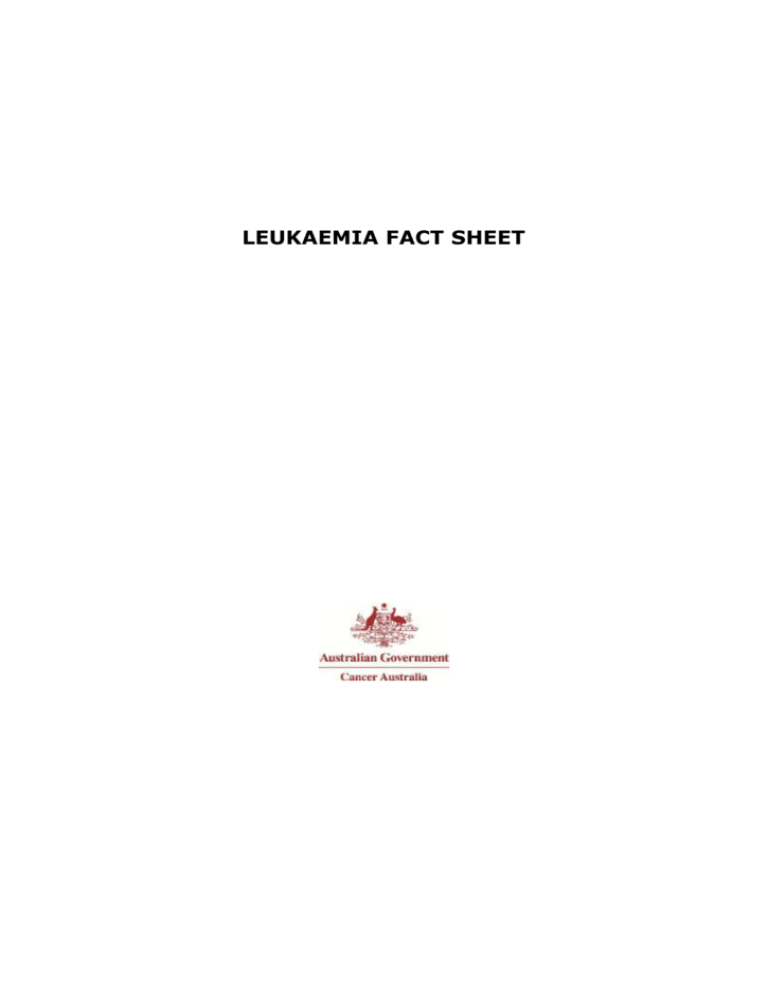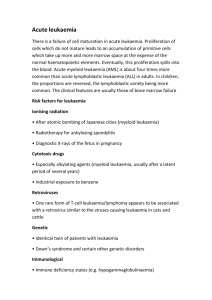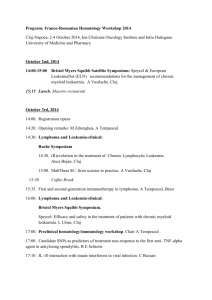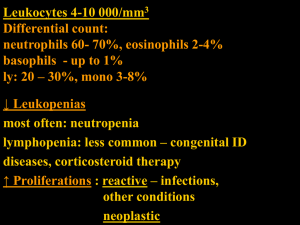Leukaemia fact sheet
advertisement

LEUKAEMIA FACT SHEET What is leukaemia? Leukaemia occurs when abnormal cells within the bone marrow grow in an uncontrolled way, affecting the production of white blood cells. White blood cells are important to help the body fight infections.1 In leukaemia the bone marrow produces abnormal white blood cells. These cells can build up in the blood and stop the normal blood cells from working properly.1 The abnormal cells can collect in different parts of the body. What are the different types of leukaemia? White blood cells develop from stem cells that are produced by the bone marrow. There are two types of stem cells that can form white blood cells - lymphoid stem cells and myeloid stem cells. Leukaemia can affect either of these types of cells.1 Different types of leukaemia are named after the cells that are affected, and how quickly the abnormal cells grow: acute lymphocytic leukaemia (ALL) affects lymphoid stem cells and grows quickly; it is the most common type of leukaemia in children. 1,3 chronic lymphocytic leukaemia (CLL) affects lymphoid stem cells and usually grows slowly; it is the most common type of leukaemia in adults.1,2 acute myeloid leukaemia (AML) affects myeloid stem cells and grows quickly.1,5 chronic myeloid leukaemia (CML) affects myeloid stem cells and grows slowly. 1,4 What are the symptoms of leukaemia? Symptoms of leukaemia depend on the number of leukaemia cells in the blood, and where these cells collect in the body. Some people with chronic leukaemia may not have any symptoms. Their diagnosis may be made after a routine blood test for some other reason. Symptoms of chronic and acute leukaemia can include:1-6 swollen or enlarged lymph nodes (especially in the neck or armpit) unexplained fevers night sweats frequent infections sustained fatigue, feeling tired or weak easy bruising or bleeding a swollen abdomen unexplained weight loss pain in the bones or joints. There are a number of conditions that may cause these symptoms, not just leukaemia. If any of these symptoms are experienced, it is important that they are discussed with a doctor. What are the risk factors for leukaemia? A risk factor is any factor that is associated with an increased chance of developing a particular health condition, such as leukaemia. There are different types of risk factors, some of which can be modified and some which cannot. It should be noted that having one or more risk factors does not mean a person will develop leukaemia. Many people have at least one risk factor but will never develop leukaemia, while others with leukaemia may have had no known risk factors. Even if a person with leukaemia has a risk factor, it is usually hard to know how much that risk factor contributed to the development of their disease. While the causes of leukaemia are not fully understood, there are a number of factors associated with the risk of developing the disease. These factors include: exposure to high levels of radiation, such as radiation from an atomic bomb explosion exposure to chemicals such as benzene previous treatment with chemotherapy or radiotherapy having certain genetic disorders, such as Down syndrome a personal history of other blood disorders, such as myelodysplastic syndrome tobacco smoking a family history of leukaemia. How is leukaemia diagnosed? A number of tests will be performed to investigate symptoms of leukaemia and confirm a diagnosis. Some of the more common tests include:1 a physical examination examination of a blood sample taking a sample of bone marrow for examination under a microscope - this is called a bone marrow aspiration sometimes, a small piece of bone is also removed for examination - this is called a bone marrow biopsy. Treatment options Treatment and care of people with cancer is usually provided by a team of health professionals - called a multidisciplinary team. Treatment for leukaemia depends on the stage of the disease, the severity of symptoms and the person's general health. Treatment options can include chemotherapy, radiotherapy and/or targeted therapies to destroy cancer cells.1 Some patients may be offered a stem cell transplant.1 For some people with slow growing (chronic) leukaemia and no symptoms, treatment may not be recommended straight away. This is called 'watchful waiting'.1 Research is ongoing to find new ways to diagnose and treat different types of cancer. Some people may be offered the option of participation in a clinical trial to test new ways of treating leukaemia. Finding support People often feel overwhelmed, scared, anxious and upset after a diagnosis of cancer. These are all normal feelings. Having practical and emotional support during and after diagnosis and treatment for cancer is very important. Support may be available from family and friends, health professionals or special support services. In addition, State and Territory Cancer Councils provide general information about cancer as well as information on local resources and relevant support groups. The Cancer Council Helpline can be accessed from anywhere in Australia by calling 13 11 20 for the cost of a local call. More information about finding support can be found on the Cancer Australia website www.canceraustralia.gov.au or the Australian Leukaemia Foundation www.leukaemia.org.au CanTeen is a national support organisation for 12 - 24 year olds who are living with cancer www.canteen.org.au References 1. National Cancer Institute. What you need to know about leukaemia – patient booklet. Available from http://www.cancer.gov/cancertopics/wyntk/leukemia/page6 [Accessed July 2012]. 2. National Cancer Institute. Chronic lymphocytic leukaemia (PDQ) – patient version. Available from http://www.cancer.gov/cancertopics/pdq/treatment/CLL/Patient [Accessed July 2012]. 3. National Cancer Institute. Adult acute lymphoblastic Leukaemia (PDQ) – patient version. Available from http://www.cancer.gov/cancertopics/pdq/treatment/adultALL/Patient/page4 [Accessed July 2012]. 4. National Cancer Institute. Chronic myelogenous leukaemia (PDQ) – patient version. Available from http://www.cancer.gov/cancertopics/pdq/treatment/adultAML/Patient [Accessed July 2012]. 5. National Cancer Institute. Adult acute myeloid leukaemia (PDQ) – patient version. Available from http://www.cancer.gov/cancertopics/pdq/treatment/adultAML/Patient [Accessed July 2012]. 6. Haematological Cancer. Suspected cancer in primary care: guidelines for investigation, referral and reducing ethnic disparities. New Zealand Guidelines Group 2009, National Guidelines Clearing House US Dept of Health & Human Services Agency for Healthcare Research and Quality. While Cancer Australia develops material based on the best available evidence, this information is not intended to be used as a substitute for an independent health professional's advice. Cancer Australia does not accept any liability for any injury, loss or damage incurred by use of or reliance on the information contained in this document. © Cancer Australia 2013.






